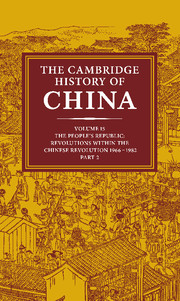Crossref Citations
This Book has been
cited by the following publications. This list is generated based on data provided by Crossref.
Whyte, Martin King
1993.
Deng Xiaoping: The Social Reformer.
The China Quarterly,
Vol. 135,
Issue. ,
p.
515.
McLellan, David
2003.
The Cambridge History of Twentieth-Century Political Thought.
p.
282.
Harding, Neil
2003.
The Cambridge History of Twentieth-Century Political Thought.
p.
239.
Khilnani, Sunil
2003.
The Cambridge History of Twentieth-Century Political Thought.
p.
299.
McLellan, David
2003.
The Cambridge History of Twentieth-Century Political Thought.
p.
267.
Geary, Dick
2003.
The Cambridge History of Twentieth-Century Political Thought.
p.
217.
Quinn-Judge, Sophie
2005.
The Ideological Debate in the DRV and the Significance of the Anti-Party Affair, 1967–68.
Cold War History,
Vol. 5,
Issue. 4,
p.
479.
Zhao, Jingsong
McCormick, John
and
Hoekman, Katherine
2008.
Idiocentrism‐allocentrism and academics' self‐efficacy for research in Beijing universities.
International Journal of Educational Management,
Vol. 22,
Issue. 2,
p.
168.
Goodman, David S. G.
2009.
Sixty years of the People's Republic: local perspectives on the evolution of the state in China.
The Pacific Review,
Vol. 22,
Issue. 4,
p.
429.
Gong, Fang
and
Li, Jun
2010.
Seeking excellence in the move to a mass system: Institutional responses of key Chinese comprehensive universities.
Frontiers of Education in China,
Vol. 5,
Issue. 4,
p.
477.
Zhouxiang, Lu
2013.
From Hongkew Recreation Ground to Bird's Nest: The Past, Present and Future of Large Sports Venues in China.
The International Journal of the History of Sport,
Vol. 30,
Issue. 4,
p.
422.
Changsong, Nam Wang
and
Hashim, Rohani
2014.
How Chinese Youth Cinema Develops? Reviewing Chinese Youth Genre in Mainland China, Taiwan and Hong Kong, 1950s-2000s.
GATR Global Journal of Business Social Sciences Review,
Vol. 2,
Issue. 1,
p.
54.
Yan, Fei
2015.
Rival Rebels.
Modern China,
Vol. 41,
Issue. 2,
p.
168.
Changfu, Xu
2015.
Why do we need practical wisdom? A Chinese lesson in the process of globalisation.
Global Discourse,
Vol. 5,
Issue. 4,
p.
519.
Hu, Chao S.
Ferrari, Michel
Liu, Ru-De
Gao, Qin
and
Weare, Ethan
2016.
Mainland Chinese Implicit Theory of Wisdom: Generational and Cultural Differences.
The Journals of Gerontology Series B: Psychological Sciences and Social Sciences,
p.
gbw157.
Zang, Leizhen
and
Wang, Puqu
2018.
Balancing Local Concerns and Global Views: Western Administrative Theory in China's Reform Practices.
Asian Politics & Policy,
Vol. 10,
Issue. 1,
p.
56.
Luo, Mengyu
2018.
Cultural policy and revolutionary music during China’s Cultural Revolution: the case of the Shanghai Symphony Orchestra.
International Journal of Cultural Policy,
Vol. 24,
Issue. 4,
p.
431.
Vorobyova, T. A.
and
Yungblud, V. T.
2019.
Relations within «Triangle» USA – USSR – China at the End of Détente (1977–1980).
MGIMO Review of International Relations,
Vol. 64,
Issue. 1,
p.
59.
Zang, Leizhen
2019.
Re-understanding of Contemporary Chinese Political Development.
p.
3.
Fang, Daqi (Reinhardt)
2024.
The Historical Different Meanings of Chinese Communist Party’s ‘The Party Commands Gun’ Under Mao Zedong and Deng Xiaoping.
China Report,
Vol. 60,
Issue. 1,
p.
76.





